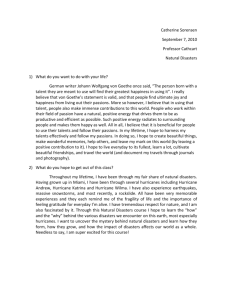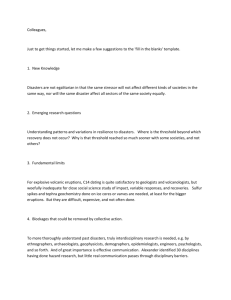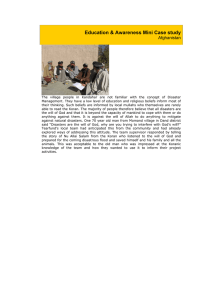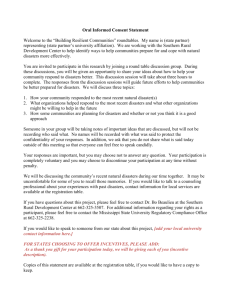Proceedings of World Business, Finance and Management Conference
advertisement
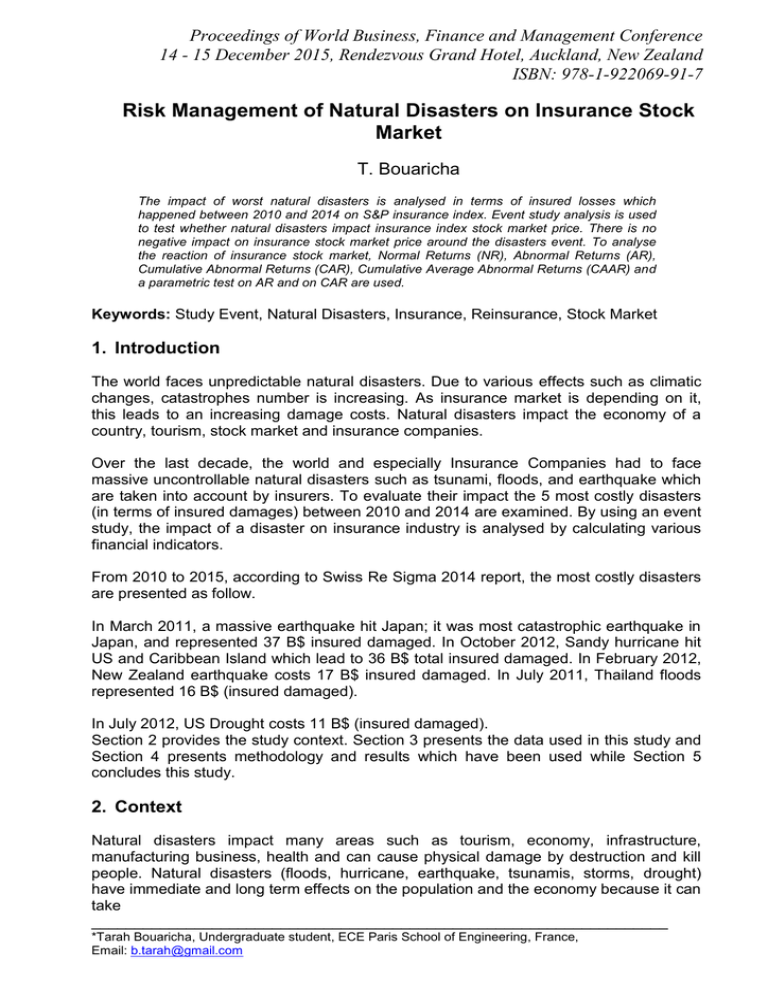
Proceedings of World Business, Finance and Management Conference 14 - 15 December 2015, Rendezvous Grand Hotel, Auckland, New Zealand ISBN: 978-1-922069-91-7 Risk Management of Natural Disasters on Insurance Stock Market T. Bouaricha The impact of worst natural disasters is analysed in terms of insured losses which happened between 2010 and 2014 on S&P insurance index. Event study analysis is used to test whether natural disasters impact insurance index stock market price. There is no negative impact on insurance stock market price around the disasters event. To analyse the reaction of insurance stock market, Normal Returns (NR), Abnormal Returns (AR), Cumulative Abnormal Returns (CAR), Cumulative Average Abnormal Returns (CAAR) and a parametric test on AR and on CAR are used. Keywords: Study Event, Natural Disasters, Insurance, Reinsurance, Stock Market 1. Introduction The world faces unpredictable natural disasters. Due to various effects such as climatic changes, catastrophes number is increasing. As insurance market is depending on it, this leads to an increasing damage costs. Natural disasters impact the economy of a country, tourism, stock market and insurance companies. Over the last decade, the world and especially Insurance Companies had to face massive uncontrollable natural disasters such as tsunami, floods, and earthquake which are taken into account by insurers. To evaluate their impact the 5 most costly disasters (in terms of insured damages) between 2010 and 2014 are examined. By using an event study, the impact of a disaster on insurance industry is analysed by calculating various financial indicators. From 2010 to 2015, according to Swiss Re Sigma 2014 report, the most costly disasters are presented as follow. In March 2011, a massive earthquake hit Japan; it was most catastrophic earthquake in Japan, and represented 37 B$ insured damaged. In October 2012, Sandy hurricane hit US and Caribbean Island which lead to 36 B$ total insured damaged. In February 2012, New Zealand earthquake costs 17 B$ insured damaged. In July 2011, Thailand floods represented 16 B$ (insured damaged). In July 2012, US Drought costs 11 B$ (insured damaged). Section 2 provides the study context. Section 3 presents the data used in this study and Section 4 presents methodology and results which have been used while Section 5 concludes this study. 2. Context Natural disasters impact many areas such as tourism, economy, infrastructure, manufacturing business, health and can cause physical damage by destruction and kill people. Natural disasters (floods, hurricane, earthquake, tsunamis, storms, drought) have immediate and long term effects on the population and the economy because it can take ___________________________________________________________________ *Tarah Bouaricha, Undergraduate student, ECE Paris School of Engineering, France, Email: b.tarah@gmail.com Proceedings of World Business, Finance and Management Conference 14 - 15 December 2015, Rendezvous Grand Hotel, Auckland, New Zealand ISBN: 978-1-922069-91-7 time to rebuild infrastructure and to provide local food supply and medical healthcare. The damaged losses from natural disasters have heavy cost. To manage it, insurers cede a portion of the business to one or more reinsurer companies which help them to mitigate losses from natural disasters by providing capital to economy and to reduce their solvency risk. Here emphasis is put on the five most costly natural disasters from 2010 to 2014. Study before 2010 can biased the results due to 2007-2008 World financial crisis. The value of insurance company should be impacted by natural disasters event in particular due to high insured losses. 3. Data The daily stock market prices have been taken from S&P Insurance index which represents the largest insurance companies worldwide and the benchmark MSCI world for the period of 2010 to 2015 from Yahoofinance.com. To analyse the insurance and reinsurance areas, Standard & Poor’s Insurance historical stock market price is used. S&P Insurance index is composed of 49 US Insurance/ Reinsurance firms. The study focuses on the 5 most costly damages occurred between 2010 and 2014. This period is chosen not to be affected by 2008-2009 financial crisis period. Data are composed by collecting stock prices in the time interval around natural disasters event. All data have been uploaded in Excel to be analysed by calculating statistical indicators. 4. Results and Discussion 4.1 Objective of the Study: The purpose of this study is to determine whether natural disasters impact insurer stock prices. The 5 most insured damaging disasters between 2010 and 2014 are examined by using an event study, and the insurance market response is compared to these disasters. When the disasters occurred on a non-trading day, the event date is chosen as the next trading day. The impact is analysed around the event date. The event study has been analysed over 1 year scale. The daily return has been calculated from closing data USD price of S&P Insurance index and MSCI World index (market benchmark). 4.2 Methodology: The methodology used to achieve the objective of this study is presented as follows. The event analysis has been used to study whether natural disasters affect significantly the value of insurance market. Firstly, performance has been calculated. The time is settled for the event study. Secondly, the abnormal return (AR) has been calculated for S&P Insurance index. Then the Cumulative abnormal return (CAR) is derivate from the AR calculus. The t-test test has been used to test whether cumulative abnormal returns of S&P Insurance index is equal to zero. A. Analysis S&P Insurance Index Performance The behavioural evolution of S&P Insurance index has been compared to its market benchmark MSCI world calculating the normalized price of each index on a daily basis: Proceedings of World Business, Finance and Management Conference 14 - 15 December 2015, Rendezvous Grand Hotel, Auckland, New Zealand ISBN: 978-1-922069-91-7 (1) Where: - Si,t is the normalized price (basis 100), - Pi,t is the stock market price at time t, - Pn is the first index price. Figure 1: S&P Insurance Index and MSCI world Stock Market Evolutions (20092015) B. Event Definition The first step is to define the event date, which corresponds to the day when the natural disasters occurred. The timeline of event study is subdivided in 3 periods. The first one is the event period which is composed of the natural disaster event day (t=0) and 10 days before and after this event (t1,t2). The second one is the gap period (T2,t1) which corresponds to a time period between the event period and the estimation period. The last one is the estimation period (T1,T2) before event and gap periods, with a certain number of observed trading days depending on availability of historical data. The longer is this period, the better will be the estimation of normal return to be the most efficient as possible (no further impact which can affect this estimation). Figure 2: Event Study Timeline Proceedings of World Business, Finance and Management Conference 14 - 15 December 2015, Rendezvous Grand Hotel, Auckland, New Zealand ISBN: 978-1-922069-91-7 The 5 analysed natural disasters analysed in the event study are presented in Table 1. Natural Disasters Japan earthquake Date Event Period Gap Period 11/03/2011 25/02 - 25/03 2 months Sandy hurricane New Zealand earthquake 24/10/2012 10/10 - 09/11 2 months 22/02/2011 07/02 - 08/03 2 months Thailand floods 27/01/2011 12/01 - 10/02 2 months 15/07/2012 * 29/06 - 30/07 2 months US Corn Belt Estimation Period 22/12/2010 22/12/2009 07/08/2012 05/08/2011 02/12/2010 03/12/2009 10/11/2010 10/11/2009 25/05/2012 25/05/2011 Table 1: 5 Most Costly Natural Disasters in 2010-2014 Period (*next trading day) C. Return The return has been calculated for S&P Insurance index and for reference market benchmark as follows: (2) Where Ri,t is the return, Pi,t is the index price at time t. D. Normal Return The normal return of S&P Insurance index stock market is approximated by using Market Adjusted Returns method which takes into account the market reference to have the same behaviour. To judge the impact of returns, actual returns (the returns affected by the natural disaster event) need to be compared with normal returns (the normal return is the period when nothing happens which can impact significantly the return). The model used to analyse the data of estimation period is CAPM which takes the risk and the return of stock market. From Brown (1985), E(Ri) = i +iRm,t (3) Where E(Ri) is the expected return (Normal Return), Ri is the daily return, Rm,t is the daily market return (MSCI world) at time t, i is the intercept and βi is the slope from the CAPM. Regression results indicate the normal return of S&P Insurance index. Display of the results is summarized on Table 1 below. Event E(Ri) Japan Earthquake i 3.104 i 1.0917 Hurricane Sandy 4.104 1.1237 New Zealand Earthquake Thailand Flood 3.104 1.0945 2.104 1.0884 US Corn Drought 4.104 1.1176 Belt Results Table F1 Table F2 Table F3 Table F4 Table F5 Table I. Display of Results for Considered Disasters Proceedings of World Business, Finance and Management Conference 14 - 15 December 2015, Rendezvous Grand Hotel, Auckland, New Zealand ISBN: 978-1-922069-91-7 E. Abnormal return The abnormal return is defined by: The calculation is (5) F. T-test statistical After calculation of the AR, the null hypothesis H0 : AR=0 is tested. It corresponds to the situation where the natural disaster event has no impact on Insurance market price. On the opposite H1: AR≠0 would mean that the natural disaster event has an impact on Insurance market price. The T-test method uses statistical general expression: ̅ (6) √ Where s is the sample standard deviation, n is the sample size, µ is the overall average value (AR), and ̅ is the sampling average value (AR). Parameter s is calculated as follow: √( ) ∑ (7) Steyx in Excel is used as regression standard error to calculate the significance of abnormal returns. The test statistic for the abnormal return is: (8) It is assumed that regression residuals are normally distributed, and that AR is significant at 95 percent level. F1. Japan Earthquake Event NR_S&P AR_S&P T_test_S&P DATE Insurance Insurance Insurance 25/03/2011 0,2% 0,3% 0,36 24/03/2011 1,1% -0,8% -1,05 23/03/2011 0,1% -0,3% -0,36 22/03/2011 0,3% -0,9% -1,13 21/03/2011 1,8% 0,2% 0,23 18/03/2011 0,7% 0,1% 0,08 17/03/2011 1,7% -1,2% -1,65 16/03/2011 -1,0% -0,2% -0,28 15/03/2011 -2,4% 1,2% 1,65 14/03/2011 -1,1% 0,4% 0,48 Event Date 11/03/2011 0,2% 0,1% 0,12 10/03/2011 -2,1% 0,3% 0,45 09/03/2011 -0,1% -0,1% -0,14 08/03/2011 0,2% 1,0% 1,30 07/03/2011 -0,7% 0,1% 0,12 04/03/2011 -0,3% -0,4% -0,54 03/03/2011 1,2% 0,7% 0,91 02/03/2011 -0,2% -0,9% -1,23 01/03/2011 -0,8% -0,7% -0,98 28/02/2011 0,9% -0,3% -0,41 25/02/2011 1,2% 0,0% 0,06 Table F1: Results of NR(eq.3), AR(eq.5) and T-test(eq.8) around Japan Earthquake Event Proceedings of World Business, Finance and Management Conference 14 - 15 December 2015, Rendezvous Grand Hotel, Auckland, New Zealand ISBN: 978-1-922069-91-7 F2. Hurricane Sandy Event Event Date NR_S&P AR_S&P T_test_S&P DATE Insurance Insurance Insurance 09/11/2012 0,0% 0,3% 0,42 08/11/2012 -1,0% 0,5% 0,54 07/11/2012 -1,9% -0,7% -0,79 06/11/2012 0,7% 0,5% 0,54 05/11/2012 -0,2% 0,4% 0,45 02/11/2012 -0,6% -1,1% -1,35 01/11/2012 1,0% -0,4% -0,51 31/10/2012 0,1% -0,2% -0,21 26/10/2012 -0,2% -0,7% -0,82 25/10/2012 0,4% 0,0% 0,04 24/10/2012 -0,1% 0,2% 0,20 23/10/2012 -1,7% 0,5% 0,63 22/10/2012 -0,1% 0,4% 0,42 19/10/2012 -1,4% -0,1% -0,10 18/10/2012 0,0% 0,4% 0,51 17/10/2012 0,9% 0,3% 0,32 16/10/2012 1,5% -0,1% -0,08 15/10/2012 0,6% 0,3% 0,35 12/10/2012 -0,2% -0,6% -0,75 11/10/2012 0,4% 0,2% 0,28 10/10/2012 -0,7% 0,8% 0,95 Table F2: Results of NR(eq.3), AR(eq.5) and T-test(eq.8) around Hurricane Sandy Event F3. New Zealand Earthquake Event NR_S&P AR_S&P T_test_S&P DATE Insurance Insurance Insurance 08/03/2011 0,2% 1,0% 1,28 07/03/2011 -0,7% 0,1% 0,12 04/03/2011 -0,3% -0,4% -0,53 03/03/2011 1,2% 0,7% 0,89 02/03/2011 -0,2% -0,9% -1,21 01/03/2011 -0,8% -0,7% -0,96 28/02/2011 0,9% -0,3% -0,41 25/02/2011 1,2% 0,0% 0,06 24/02/2011 -0,2% -0,3% -0,43 23/02/2011 -0,6% -0,4% -0,50 Event Date 22/02/2011 -1,9% -0,4% -0,54 18/02/2011 0,3% 0,5% 0,71 17/02/2011 0,7% 0,1% 0,17 16/02/2011 0,7% 0,3% 0,34 15/02/2011 0,0% 0,4% 0,49 14/02/2011 0,3% -0,9% -1,21 11/02/2011 0,3% 0,6% 0,75 10/02/2011 -0,3% 0,0% 0,03 09/02/2011 -0,4% 0,1% 0,09 08/02/2011 0,7% -0,4% -0,51 07/02/2011 0,7% 0,3% 0,38 Table F3: Results of NR, AR and T-test around New Zealand Earthquake Event F4. Thailand Floods Event NR_S&P AR_S&P T_test_S&P DATE Insurance Insurance Insurance 10/02/2011 -0,3% 0,0% 0,04 09/02/2011 -0,4% 0,1% 0,10 08/02/2011 0,7% -0,4% -0,48 07/02/2011 0,7% 0,3% 0,40 04/02/2011 0,2% 0,7% 0,85 03/02/2011 -0,2% 0,5% 0,62 02/02/2011 0,2% -1,1% -1,42 01/02/2011 1,9% 0,0% -0,03 31/01/2011 0,5% -0,4% -0,57 28/01/2011 -1,5% -0,6% -0,82 Event Date 27/01/2011 0,3% 0,5% 0,66 26/01/2011 0,6% -0,4% -0,53 25/01/2011 -0,1% 0,7% 0,95 24/01/2011 0,8% -0,3% -0,45 21/01/2011 0,6% -0,6% -0,71 20/01/2011 -1,1% 1,2% 1,59 19/01/2011 -0,6% -0,8% -1,01 18/01/2011 0,6% -0,5% -0,69 14/01/2011 0,3% 0,3% 0,44 13/01/2011 0,6% -1,0% -1,23 12/01/2011 1,4% -0,8% -1,01 Table F4: Results of NR(eq.3), AR(eq.5) and T-test(eq.8) around Thailand Flood Event Proceedings of World Business, Finance and Management Conference 14 - 15 December 2015, Rendezvous Grand Hotel, Auckland, New Zealand ISBN: 978-1-922069-91-7 F5. U.S Corn Belt Drought Event Date NR_S&P AR_S&P T_test_S&P DATE Insurance Insurance Insurance 30/07/2012 0,4% -0,1% -0,14 27/07/2012 2,1% -0,3% -0,32 26/07/2012 2,5% -1,7% -1,86 25/07/2012 -0,1% 0,4% 0,38 24/07/2012 -0,8% -0,3% -0,37 23/07/2012 -1,7% 1,0% 1,03 20/07/2012 -1,4% -0,3% -0,36 19/07/2012 0,8% -1,2% -1,28 18/07/2012 0,9% -0,7% -0,79 17/07/2012 0,4% 0,3% 0,28 16/07/2012 0,0% -0,8% -0,82 13/07/2012 1,7% 0,1% 0,06 12/07/2012 -1,0% 0,3% 0,36 11/07/2012 0,0% 0,0% -0,01 10/07/2012 -0,4% -0,2% -0,23 09/07/2012 -0,4% -0,3% -0,32 06/07/2012 -1,1% 0,4% 0,43 05/07/2012 -0,8% -0,2% -0,18 03/07/2012 1,0% 0,0% 0,00 02/07/2012 0,5% -0,1% -0,08 29/06/2012 3,4% -1,2% -1,26 Table F5: Results of NR(eq.3), AR(eq.5) and T-test(eq.8) around U.S Corn Belt Drought Event The significance level of the T-test is 5 percent level and 20 degrees of freedom. According to T table, the t0.05;20 value is 1.725. As seen in Tables F1 to F5, for the 5 natural disasters event, t ≠0, so the null hypothesis should be rejected. Moreover, t value is never less than -1.725 and greater than 1.725 which means that studied natural disasters did not impact S&P Insurance stock market price. A further statistical T-test will be performed with the CAR in the following part to confirm this result. G. Cumulative Abnormal Returns The cumulative abnormal returns calculated for the event period (t1,t2) is given by: ∑ (9) Using the CAR value, a test is performed to identify the CAR on the stock. H0: CAR=0 corresponding to the case where the natural disaster event has no impact on Insurance market price. H1: CAR≠0 where the natural disaster event has an impact on Insurance market price. The statistic t-test is calculated with: (10) Where SD is the standard deviation of AR of the stock, and N is the number of trading days (in the event period) The significance level of the T-test is 5 percent level and 20 degrees of freedom. According to T-table, the t0.05;20 value is 1.725. If t ≠0, the null hypothesis is rejected. If t is less than -1.725 or greater than 1.725, a significant impact on insurance stock market is due to the natural disaster event. Proceedings of World Business, Finance and Management Conference 14 - 15 December 2015, Rendezvous Grand Hotel, Auckland, New Zealand ISBN: 978-1-922069-91-7 G1. Japan Earthquake Figure 1: Cumulative Abnormal returns of S&P Insurance index around Japan Earthquake Event Event Date CAR_S&P T_test_S&P DATE Insurance Insurance 25/03/2011 -1,5% -0,54 24/03/2011 -1,8% -0,64 23/03/2011 -1,0% -0,36 22/03/2011 -0,7% -0,26 21/03/2011 0,1% 0,05 18/03/2011 0,0% -0,02 17/03/2011 -0,1% -0,04 16/03/2011 1,1% 0,40 15/03/2011 1,3% 0,48 14/03/2011 0,1% 0,04 11/03/2011 -0,3% -0,09 10/03/2011 -0,3% -0,12 09/03/2011 -0,7% -0,24 08/03/2011 -0,6% -0,20 07/03/2011 -1,6% -0,55 04/03/2011 -1,6% -0,58 03/03/2011 -1,2% -0,44 02/03/2011 -1,9% -0,68 01/03/2011 -1,0% -0,36 28/02/2011 -0,3% -0,09 25/02/2011 0,0% 0,02 Table G1: Results of Cumulative Normal Return and T-test G2. Hurricane Sandy Event Figure 2: Cumulative Abnormal returns of S&P Insurance Index around Hurricane Sandy Event Proceedings of World Business, Finance and Management Conference 14 - 15 December 2015, Rendezvous Grand Hotel, Auckland, New Zealand ISBN: 978-1-922069-91-7 CAR_S&P T_test_S&P DATE Insurance Insurance 09/11/2012 0,9% 0,41 08/11/2012 0,6% 0,25 07/11/2012 0,1% 0,04 06/11/2012 0,8% 0,34 05/11/2012 0,3% 0,14 02/11/2012 -0,1% -0,03 01/11/2012 1,1% 0,48 31/10/2012 1,5% 0,67 26/10/2012 1,7% 0,75 25/10/2012 2,4% 1,06 Event Date 24/10/2012 2,3% 1,04 23/10/2012 2,2% 0,97 22/10/2012 1,6% 0,73 19/10/2012 1,3% 0,57 18/10/2012 1,4% 0,61 17/10/2012 0,9% 0,41 16/10/2012 0,6% 0,29 15/10/2012 0,7% 0,32 12/10/2012 0,4% 0,19 11/10/2012 1,0% 0,47 10/10/2012 0,8% 0,36 Table G2: Results of Cumulative Normal Return and T-test G3. New Zealand Earthquake Event Figure 3: Cumulative Abnormal returns of S&P Insurance index around New Zealand Earthquake Event. CAR_S&P T_test_S&P DATE Insurance Insurance 08/03/2011 -0,8% -0,33 07/03/2011 -1,7% -0,75 04/03/2011 -1,8% -0,79 03/03/2011 -1,4% -0,61 02/03/2011 -2,1% -0,90 01/03/2011 -1,2% -0,51 28/02/2011 -0,4% -0,19 25/02/2011 -0,1% -0,06 24/02/2011 -0,2% -0,08 23/02/2011 0,1% 0,06 Event Date 22/02/2011 0,5% 0,23 18/02/2011 0,9% 0,40 17/02/2011 0,4% 0,17 16/02/2011 0,3% 0,12 15/02/2011 0,0% 0,00 14/02/2011 -0,4% -0,16 11/02/2011 0,6% 0,24 10/02/2011 0,0% 0,00 09/02/2011 0,0% -0,01 08/02/2011 -0,1% -0,04 07/02/2011 0,3% 0,13 Table G3: Results of Cumulative Normal Return and T-test Proceedings of World Business, Finance and Management Conference 14 - 15 December 2015, Rendezvous Grand Hotel, Auckland, New Zealand ISBN: 978-1-922069-91-7 G4. Thailand Floods Event Figure 4: Cumulative Abnormal Returns of S&P Insurance index around Thailand Flood Event CAR_S&P T_test_S&P DATE Insurance Insurance 10/02/2011 -2,6% -0,91 09/02/2011 -2,6% -0,93 08/02/2011 -2,7% -0,95 07/02/2011 -2,3% -0,82 04/02/2011 -2,6% -0,93 03/02/2011 -3,3% -1,17 02/02/2011 -3,8% -1,34 01/02/2011 -2,7% -0,95 31/01/2011 -2,6% -0,94 28/01/2011 -2,2% -0,78 Event Date 27/01/2011 -1,6% -0,56 26/01/2011 -2,1% -0,74 25/01/2011 -1,7% -0,59 24/01/2011 -2,4% -0,85 21/01/2011 -2,1% -0,73 20/01/2011 -1,5% -0,53 19/01/2011 -2,7% -0,97 18/01/2011 -1,9% -0,69 14/01/2011 -1,4% -0,50 13/01/2011 -1,7% -0,62 12/01/2011 -0,8% -0,28 Table G4: Results of Cumulative Normal Return and T-test G5. U.S Corn Belt Drought Figure 5: Cumulative Abnormal Returns of S&P Insurance Index around U.S Corn Belt Drought Event Proceedings of World Business, Finance and Management Conference 14 - 15 December 2015, Rendezvous Grand Hotel, Auckland, New Zealand ISBN: 978-1-922069-91-7 CAR_S&P T_test_S&P DATE Insurance Insurance 30/07/2012 -3,7% -1,34 27/07/2012 -3,6% -1,29 26/07/2012 -3,3% -1,18 25/07/2012 -1,5% -0,55 24/07/2012 -1,9% -0,68 23/07/2012 -1,5% -0,56 20/07/2012 -2,5% -0,91 19/07/2012 -2,2% -0,78 18/07/2012 -1,0% -0,35 17/07/2012 -0,2% -0,08 16/07/2012 -0,5% -0,18 13/07/2012 0,3% 0,10 12/07/2012 0,2% 0,08 11/07/2012 -0,1% -0,04 10/07/2012 -0,1% -0,04 09/07/2012 0,1% 0,04 06/07/2012 0,4% 0,15 05/07/2012 0,2% 0,09 03/07/2012 0,2% 0,09 02/07/2012 0,2% 0,06 29/06/2012 -1,0% -0,37 Table G5: Results of Cumulative Normal Return and T-test Table G1 to G5 shows that I can’t reject the null hypothesis because none of the t test value is less than -1.725 or greater than 1.725. That means that none of any natural disasters studied affects the S&P Insurance stock market. As seen in Figures 1 to 5, the CAR of S&P Insurance index did not react to any of studied natural disaster events. It means that none of them had an impact on S&P insurance stock market price. Further analysis will prove this hypothesis. H. Cumulative Average Abnormal Returns In this part, the cumulative average abnormal returns (CAAR) of S&P Insurance index is also calculated. The expression is: ( ) ∑ (10) Event Japan earthquake Sandy hurricane New Zealand earthquake Thailand floods US Corn Belt CAAR_S&P Insurance -12% 22% -7% -47% -21% Table 2: CAAR of S&P Insurance Index around Natural Disasters Event. As seen in Table 2, CAAR of S&P Insurance index is negative for Japan earthquake, New Zealand earthquake, Thailand floods, US Corn Belt event that means that those events have a negative effect S&P Insurance stock market but not a significant one as seen on T-test results. Meanwhile Sandy hurricane has a positive effect on S&P Insurance stock market as prove on T-test results. 5. Conclusion This paper examines the effect of five worst natural disasters occurred between 2010 and 2014 on S&P insurance stock market price. The results show that there was no impact on S&P Insurance. To perform a test on AR and CAR results a statistic T-test has been used. The AR and CAR do not show any impact from the 5 considered Proceedings of World Business, Finance and Management Conference 14 - 15 December 2015, Rendezvous Grand Hotel, Auckland, New Zealand ISBN: 978-1-922069-91-7 catastrophes. This is explained by the high enough level of reinsurance coverage insurance companies have up to now been globally subscribing to face the occurrence of possible disastrous events, and is a strong element in favour of seriousness of their risk management. However further studies are necessary to study in more detail the stock market price of each insurance and reinsurance company from various countries. Acknowledgments The author is very much indebted to ECE Paris School of Engineering to have provided the environment where the work has been developed and Pr M. Cotsaftis for discussion and help in preparation of the manuscript. References Aiuppa, T., Carney, R. J., & Krueger T. M., 1993. An examination of insurer stock prices following the 1989 Loma Prieta earthquake. Journal of Insurance Issues, 16(1), 114. Brown, S., and J. Warner, 1985. Using daily stock returns: The case of event studies, Journal of Financial Economics 14: 3-31. DeBondt, W., Thaler, R., 1985, Does the stock market overreact? Journal of Finance 40: 793805. Hurricane Andrew.” Journal of Risk and Insurance, 62 (1): 11-123. West, C. T. and D. G. Lenze,1994, “Modeling the Regional Impact of Natural Disaster and Recovery: A General Framework and an Application to Hurricane Andrew.” International Regional Science Review, 17 (2): 121-150. Lamb R. P., 1995, An exposure-based analysis of property-liability insurer stock values around hurricane Andrew, Journal of Risk and Insurance, 62(1), 111–23. MacKinlay, A. C., 1997, Event studies in economics and finance, Journal of Economic Literature 35: 13-39. Shleifer, A., 2000, Inefficient markets: An introduction to behavioral finance (Oxford University Press). Terhi Luoma, 2011, A Sign Test of Cumulative Abnormal Returns in Event Studies Based on Generalized Standardized Abnormal Returns. Worthington, A. C. & Valadkhani, A., 2004. Measuring the impact of natural disasters on capital markets: an empirical application using intervention analysis. Applied Economics, 36(19), 2177-2186.
